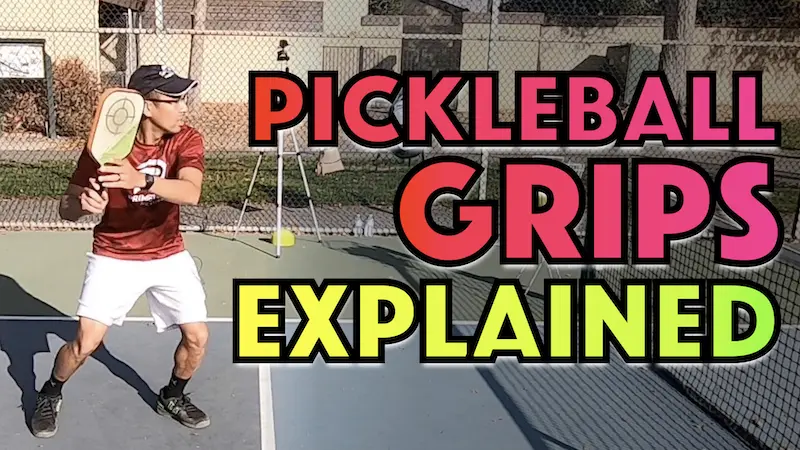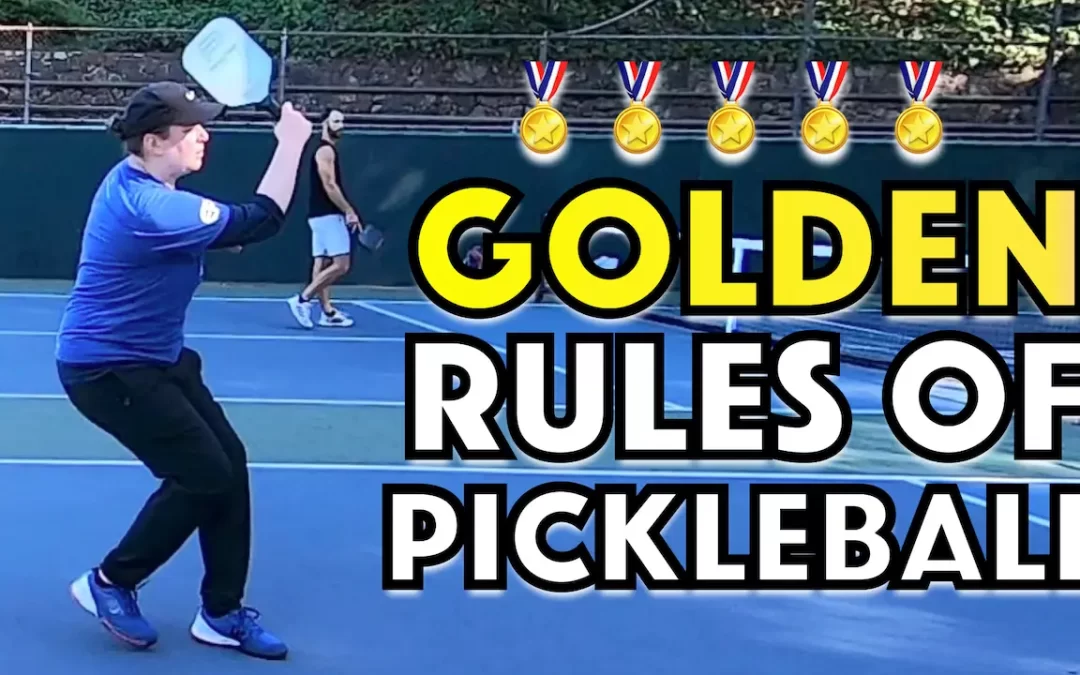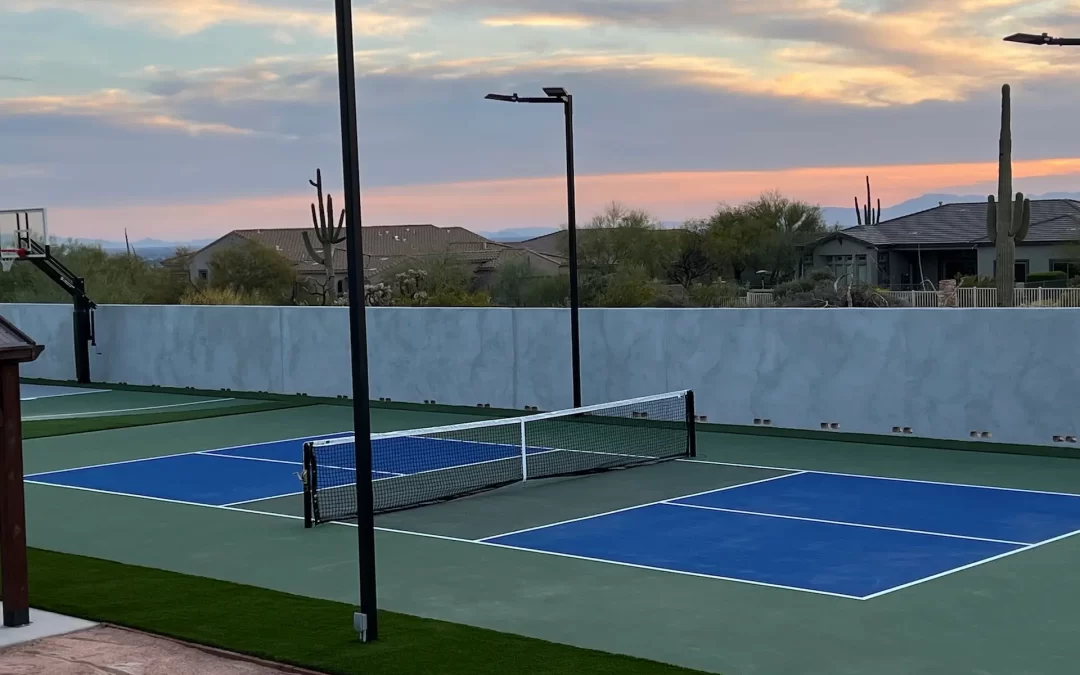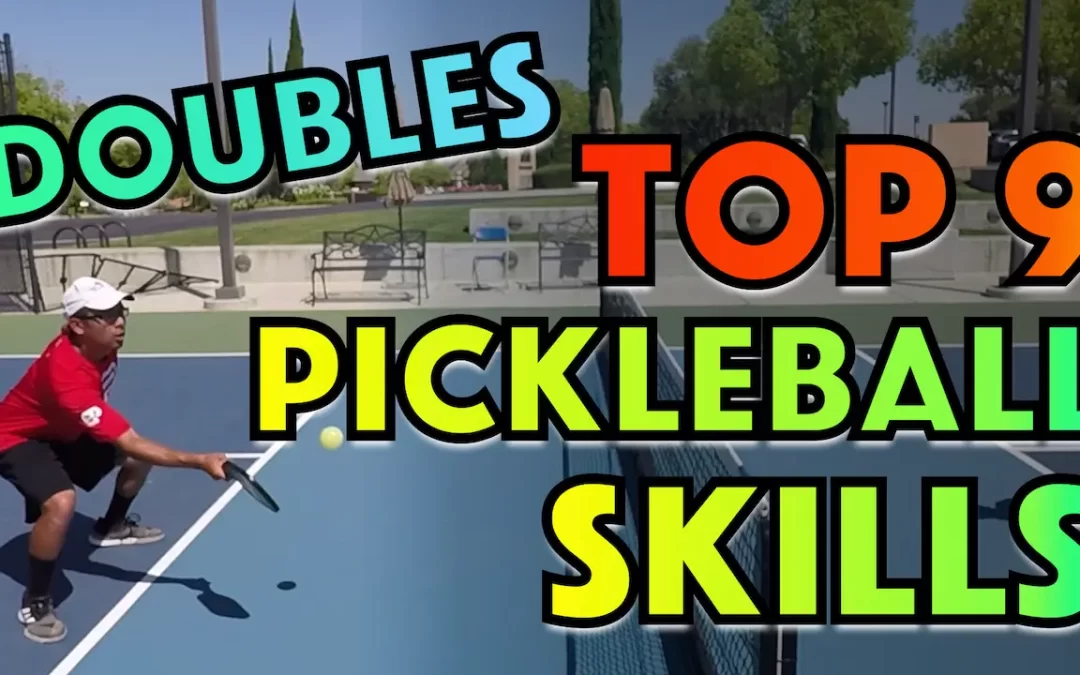There’s an interesting trend in racquet sports happening across North America.
It appears that more and more tennis players are moving over and becoming pickleball players.
What’s fueling the pickleball vs tennis game debate is the fact that during prime tennis-playing weather, tennis courts are empty.
While pickleball courts are bursting at the seams.
Pickleball facilities are popping up everywhere. And tennis courts are being converted to pickleball courts in ever-increasing numbers.
So, what gives?
What is Pickleball?
What is the attraction that continues to bring large numbers of new players to pickleball every year?
Well, it is a hugely popular sport that combines elements of tennis and other racquet sports such as badminton and table tennis (ping pong). You use a small perforated plastic ball, fiberglass and carbon fiber paddles, a net, and a small space about a ¼ the size of a tennis court.
You don’t need much skill to start, although tennis players tend to pick up the technique very quickly. It helps if you have a tennis background as the game is very similar.
If you have any other racquet sports in your background such as badminton, squash, racketball, table tennis etc… That will typically be beneficial as well. Stroke production in those sports can often be easily adapted to be very useful in pickleball.
The perforations and plastic construction of the ball ensures that it travels at a moderate speed. It is also more easily controlled due to its aerodynamic properties than a tennis ball.
There’s plenty of bounce in a tennis ball, while the plastic ball bounces a lot less, so you see fewer unforced errors because there’s less you have to do to deal with the ball and still hit good shots.
Taller players find that they bend over far more in pickleball than in tennis, which is a distinct advantage for shorter players in this respect. The longer tennis racquet makes reaching balls lower down a lot easier.
The smaller court allows one to get around it and reach a variety of shots more easily. Because pickleball is overall less physically demanding than tennis, a wider variety of players tend to gravitate towards it.
Having Fun Is the Focus
Pickleball is a highly social sport and many are in it primarily for the fun and laughs but don’t be lulled into a false sense of complacency, as the game is not so easy that quick reflexes and good hand-eye coordination aren’t needed. And even though fun is at the forefront, players still like to win so be ready for some competition.
A reasonable level of fitness won’t go amiss as there’s plenty of bending, stretching, and changes of direction in every game. The game also moves along more quickly than in tennis, with less time taken between points. And since the court is smaller, the players spend less time chasing balls and walking to their starting positions for the next point. Though rallies may be extended, time between points is often notably less.
The rules are kept to a minimum, so players from other racquet-based games will pick them up easily.
The focus is on having fun.
Both singles and doubles games provide plenty of excitement and entertainment for the young and old. It’s a social game as you’re close to both your opponent and your partner in doubles games.
You can play pickleball indoors or outdoors, so it’s a great game for those of you who want something to do year-round.
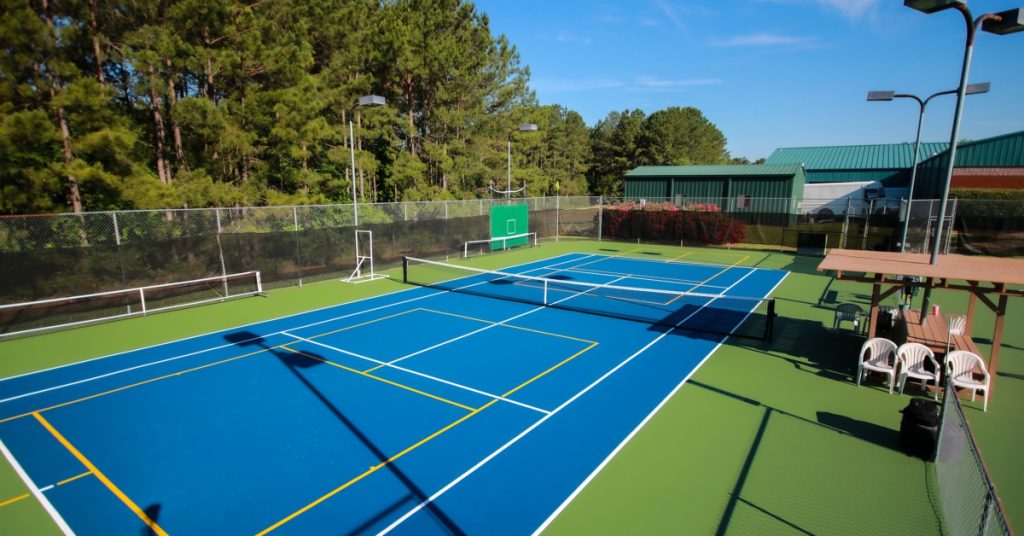
Pickleball & Tennis Sports Major Differences
The game of pickleball has a lot in common with tennis.
In both cases, you use a piece of equipment that has a handle and a hitting face (racket or paddle), a ball and a court with a net. You also may often find yourself playing pickleball on a tennis club court, as many courts have been converted for pickleball play, either temporarily or permanently.
Let’s look at the differences between tennis and pickleball.
Pickleball Paddle Vs Tennis Racquets
Pickleball paddles are much shorter than tennis racquets and another major notable difference is that tennis rackets have a string bed while pickleball paddles have a solid surface over the entire face of the paddle much like a table tennis paddle.
Pickleball paddles are typically made of plastic, fiberglass or carbon fiber or some combination thereof. The face is often mostly square and the elongated versions are more rectangular in shape. Tennis players often prefer the elongated versions because they have a higher sweet spot closer to what they are used to with a tennis racquet.
Paddle companies are continuously experimenting with different materials and shapes and other features of paddles in an effort to optimize feel, aerodynamics and durability.
Additionally, paddles come in a bigger variety of grip lengths and thicknesses than tennis rackets do.
The paddles are far easier to wield as your hand is much closer to the striking zone. Tennis players need to spend a lot of time fine-tuning their grip and swing in order to properly maneuver the racquet for optimal leverage on the ball.
Grab a few pickleball balls, your paddle, and hit the court. There is really no need for a single lesson. Get a few pointers from your fellow players and you can be off to the races and set to play in no time at all.
Pickleball vs Tennis Ball
One of the biggest differences between the games is the ball. The pickleball is of a similar size to a tennis ball but is made of perforated plastic. A tennis ball is made from rubber at its core covered by a felt exterior.
There is significantly less bounce in a pickleball compared to a tennis ball and it travels a lot slower when you hit the ball. The maximum speed of pickleball tops out at approximately 1/3 of the maximum speed of a tennis ball.
This allows newcomers to the sport to play reasonably well in a short period. They have far more time to deal with each shot which makes things a lot easier on the player.
If you are a tennis player transitioning to pickleball, you’ll have no problem mastering the techniques and switching from tennis balls to pickleballs. Strokes are shorter and choppier than in tennis and the skill needed to control the ball is far less.
Pickleball Court vs Tennis Court
A tennis court is much larger than a pickleball court. In fact, 4 pickleball courts can fit quite neatly into the footprint of a tennis court.
The pickleball court is 44 feet from baseline to baseline and is 20 feet wide. There’s a 7-foot no volley zone on each side of the net called the “Kitchen”. You can’t touch anywhere inside this area if you’ve volleyed a shot.
In comparison, a tennis court is 78 feet long and 36 feet wide. This means that you have far less space to run around on a pickleball court.
There’s lots of back and forth rallies in pickleball for players of all levels. Though the rallies may still seem quick since players are so much closer together on most shots so you do need to be alert.
Intermediate and advanced tennis player often do have extended rallies but beginners will have much shorter ones due to their lack of control. Beginner tennis players will spend most of their on court time retrieving balls between rallies.
This is not so for beginner pickleball players thanks to the smaller court and more manageable reaction from the ball.
Serving
In pickleball, you serve across the center line diagonally into one half of the court and beyond the non-volley zone line.
You will be serving from right to left and left to right as depend on the score and who’s turn it is to serve and just generally where things are at in the game.
In tennis, you also serve diagonally from right to left and left to right depending on the score however, the service box is in the front part of your opponents court rather than the back part.
The return of serve in both pickleball and tennis can land anywhere in the opponents court.
You can play a singles game or a doubles game on the same sized court in pickleball whereas in tennis, the court is wider by 4.5 feet on each side for doubles.
Differences Between Pickleball and Tennis Scoring
You typically play for 11 points and win by 2 points in a pickleball game. A competitive pickleball tournament will have different rules. You may find that they play one game to 15 or 21 points depending on the competition or the place that match has in the draw.
When playing pickleball, only the serving team can win a point by winning a rally.
Pickleball matches are won by the player or team that wins 2 out of 3 games
In tennis, the scoring system is such that both sides able to score on each point played. You typically need to win 6 games in order to win a set in tennis and 2 out of 3 sets wins the match.
During a pickleball game, the right-hand player serves across the center-line. If the serving team wins the rally, then the players on the same team swap sides (between right and left) and the original server (number 1) serves from the left side of the court.
If server number 1 loses the serve, then player number 2 becomes the server and serves from their current position. They continue to play and swap sides on each point until they lose a rally. Then the serve swaps over to the opposing team.
This is known as a side out.
The opposing team then has 2 chances to serve.
At the beginning of the game, the team that serves first starts as server number 2. This is so that the serving team is not given an unfair advantage. Should the first server (number 2) lose the initial rally, then the serve immediately changes to the opposing team.
In singles games, each player only has one serving opportunity. Should they lose a point, then the serve immediately changes to the opposing player.
In tennis, you can step anywhere on your side of the court at anytime. In pickleball, there’s an area in front of the net, often referred to as “the kitchen”, that is a non-volley zone. If you step into that area and take the ball out of the air (volley), you lose the point.
In both tennis and pickleball, the ball cannot bounce more than once before being returned.
In tennis, you can hit an overhand shot at anytime, including the serve. In pickleball you can hit an overhead shot at anytime in the point except you must serve underhand.
Is a Pickleball Game Easier To Play Than a Tennis Game?
Pickleball is much easier to play than tennis for a beginner, and it certainly does help if you have a background in tennis or another racquet sport.
Beginners can pick up most of the important aspects of pickleball and play a game on their first outing to the courts.
The stroke techniques are more abbreviated and generally easier to learn and controlling the ball speed and spin is relatively easy with a little practice. Play a few games and you’ll be able to play quite competitively.
Two beginners can engage in a back and forth rally in pickleball right away in most cases. This is not true in tennis in most cases.
Two beginner tennis players will be very lucky to have a three-ball rally. In most cases, one or two shots will be struck and they will spend the majority of their time walking to pick up balls.
You can become an advanced pickleball player much faster than a top-level tennis player.
In contrast, tennis requires lessons and plenty of practice to improve your game. The swing is much longer in tennis and much more technical in nature. The contact point is further away from you since the racket is longer and the ball is significantly bouncier and harder to control.
You have a lot more control over shot placement using a pickleball paddle than a tennis racquet thanks to a contact point close to you hand and a ball that is less bouncy and travels slower through the air.
Serving technique in tennis is a complicated motion and can take weeks of practice and, even then, it is not easy to accomplish perfectly each time. Pickleball serves are accomplished underhand and generally easier since the forehand motion used is much easier than an overhead swing motion.
This makes it much easier to control the ball and even novices get it right within a very short space of time.
With an emphasis on fun and it being an overall easier sport for all, pickleball is great sport for family, friends, couples etc… Multiple generations can play together since the sport is such a great equalizer which can’t be said of most sports.
That is a large part of what is fueling the explosive growth of the sport nationwide.
Final Thoughts
It is not hard to see why the newly popular sport of pickleball is taking off around the country at the expense of tennis.
The growth of pickleball can be attributed to its ease of play, minimal rules, and inexpensive equipment.
A tennis game is more complex, take longer to master and is less accessible to players of advanced age and limited mobility.
Due to the small size of the court, it’s even more suitable for indoor play than tennis since you can fit more courts in a smaller area, which makes it a perfect year-round sport.
A new pickleball player, with or without a previous racquet sports background, can play games their first time out and become very proficient quite quickly. A racquets sports background certainly does help and will usually accelerate your progress at every stage.
Players tend to become addicted to the game and often find themselves playing several times a week
For older tennis players who are no longer as fit or as agile as they once were, pickleball offers them an alternative game. It is every bit as enjoyable as tennis with less running and less chance of injury.
You still need quick reflexes for a couple reasons:
- You are much closer to your opponents than in tennis and the ball is traveling a shorter distance to your opponents therefore it will come back quicker in that respect.
- Power shots in pickleball still get the ball traveling quite fast and do present a challenge to human reflexes. Therefore, power is still a major factor in the game.
Considering all that we’ve covered here, we hope that it’s not hard to see why the game continues to attract a huge amount of attention from players of all ability levels.
Pickleball is the fastest growing sport in America and interest is not showing any sign of slowing down.


